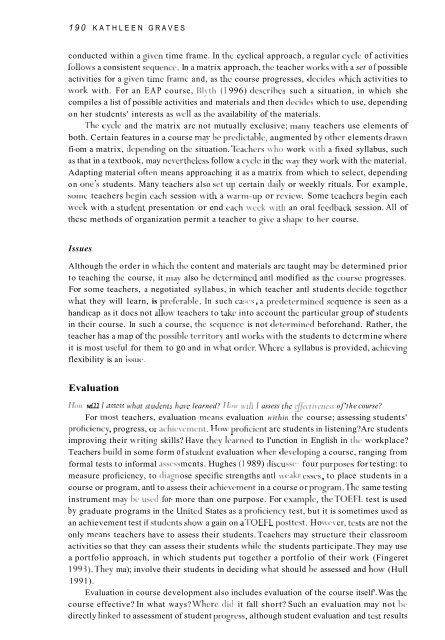Download - Search
Download - Search
Download - Search
You also want an ePaper? Increase the reach of your titles
YUMPU automatically turns print PDFs into web optimized ePapers that Google loves.
190 KATHLEEN GRAVESconducted within a givcn time frame. In the cyclical approach, a regular cyclc of activitiesf'ollo\vs a consistent sequrncc. In a matrix approach, the teacher xvorks with a set of possibleactivities for a givcn time frame and, as thc course progresses, dccides which activities tolvork with. For an EAP course, I3lyth (1 996) dcscrilm such a situation, in which shecompiles a list of possible activities and materials and then tlccidcs which to use, dependingon her studcnts' interests as \vcll as the availability of the materials.The cyclc and the matrix arc not mutually exclusive; inany teachers use elements ofboth. Certain features in a course ma! lie predictable, augmented by other elements drawnfi-om a matrix, dcpcnding on the situation. Teachers who work with a fixed syllabus, suchas that in a textbook, may nevertheless follow a cjclc in thc way they lvork with the material.Adapting material oftcn means approaching it as a matrix from which to select, dependingon onc's students. Many teachers also set up certain tlaily or weekly rituals. For example,somc teachers hegin cach session \vith a \varm-up or review. Some tcachrrs liegin eachweek with a student presentation or end cach \vcck with an oral feetlback session. All ofthcsc methods of organization permit a teacher to gi\c a shap to her course.IssuesAlthough thc order in \vhich thc content and materials arc taught may hc determined priorto teaching the course, it ma! also bc dctcrniinctl antl modified as the coursc progresses.For some teachers, a negotiated syllabus, in which teacher antl students decide togcthcrwhat they will learn, is prcfcralile. In such ca~ , a predetermined scqu'nce is seen as ahandicap as it docs not alhv teachers to takc into account the particular group of' studentsin thcir course. In such a course, the sequence is not dctcrminetl beforehand. Rather, theteacher has a map of the possihlc tcrritor! antl \vorks \vith the students to dctcrmine whereit is most useful for them to go and in bvhat order. Whet-c a syllabus is provided, achicvingflexibility is an issue.EvaluationHow will I u.s.sc.ss ithat stiitlents have learned? Him. iv711 I assess the $fictivcnc.s.s of'the course?For most teachers, evaluation tncans evaluation ivithin the course; assessing students'proticiency, progress, or achie\micnt. Ho\v proficient arc students in listening? Arc studentsimproving their \\.riting skills? Have the); Icw-iied to I'unction in English in the workplace?Teachers liuild in some form of studcnt evaluation when developing a coursc, ranging fromformal tests to informal mcnts. Hughes (1 989) tliscu ' four purposcs for testing: tomeasure proficicncy, to ose specific strengths antl w csscs, to place students in acourse or program, antl to assess their achicvvment in a course or program.Thc same testinginstrument may be used for- more than one purpose. For cxamplc, thcTOEFL test is usedby graduate programs in the United States as a proficicncy test, but it is sometimes used asan achievement test ifstutlcnts show a gain on a7'OEFL posttcst. Ho cr, tests are not theonly means teachers have to assess their students. Tcachcrs may structure their classroomactivities so that they can assess their students whilc the students participate. They may usea portfolio approach, in which students put togcthcr a portfolio of their work (Fingeret1993).They ma); involve their students in deciding what should be assessed and how (Hull1991).Evaluation in course development also includes evaluation of the course itself'. Was thecourse effective? In what ways? Where (lid it fall short? Such an evaluation may not bedirectly linked to assessment of student progrcss, although student evaluation and test results


